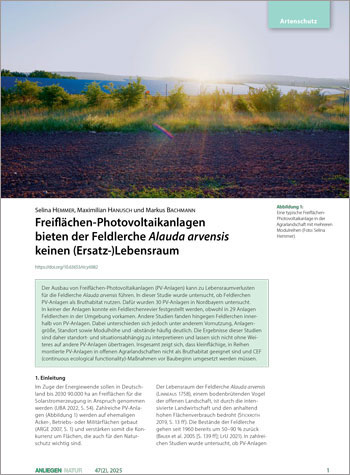Freiflächen-Photovoltaikanlagen bieten der Feldlerche Alauda arvensis keinen (Ersatz-)Lebensraum

Eine typische Freiflächen-Photovoltaikanlage in der Agrarlandschaft mit mehreren Modulreihen (Foto: Selina Hemmer).
Selina Hemmer, Maximilian Hanusch und Markus Bachmann
https://doi.org/10.63653/ricy6982
Der Ausbau von Freiflächen-Photovoltaikanlagen (PV-Anlagen) kann zu Lebensraumverlusten
für die Feldlerche Alauda arvensis führen. In dieser Studie wurde untersucht, ob Feldlerchen
PV-Anlagen als Bruthabitat nutzen. Dafür wurden 30 PV-Anlagen in Nordbayern untersucht.
In keiner der Anlagen konnte ein Feldlerchenrevier festgestellt werden, obwohl in 29 Anlagen
Feldlerchen in der Umgebung vorkamen. Andere Studien fanden hingegen Feldlerchen innerhalb
von PV-Anlagen. Dabei unterschieden sich jedoch unter anderem Vornutzung, Anlagengröße,
Standort sowie Modulhöhe und -abstände häufig deutlich. Die Ergebnisse dieser Studien
sind daher standort- und situationsabhängig zu interpretieren und lassen sich nicht ohne Weiteres auf andere PV-Anlagen übertragen. Insgesamt zeigt sich, dass kleinflächige, in Reihen
montierte PV-Anlagen in offenen Agrarlandschaften nicht als Bruthabitat geeignet sind und CEF
(continuous ecological functionality)-Maßnahmen vor Baubeginn umgesetzt werden müssen.
Summary
Ground-mounted photovoltaic systems do not serve as substitute habitats for the skylark (Alauda arvensis)
The expansion of ground-mounted photovoltaic systems (PV) can lead to habitat loss for the Skylark Alauda arvensis. This study investigated whether Skylarks use PV systems as breeding habitat. To this end, 30 PV systems in Northern Bavaria, all established within known Skylark habitats, were surveyed using territory mapping. No Skylark territories were detected within any of the PV systems, although Skylarks were present in the surrounding areas of 29 sites. Other studies, however, have documented Skylark occurrences within PV installations. These studies, though, often differed significantly in key conditions, such as previous land use, system size, location, as well as module height and spacing. Therefore, their results must be interpreted in a site- and context-specific manner and cannot be directly transferred to other PV systems. Overall, the findings indicate that small-scale, row-mounted PV systems in open agricultural landscapes are not suitable as breeding habitat and that measures must be implemented prior to construction.
Zum Volltext-Download:
Anliegen Natur 47/2 (2025): 10 Seiten als Volltext herunterladen (pdf barrierefrei 0,7 MB).
 | 0
| 0 

Sehr geehrte Damen und Herren,
Das standardgemäße Vorgehen gem. Südbeck (2005) kann doch für eine Revierkartierung in vorliegender Ausführung nicht proklamiert werden. Vorgabe ist das Abgehen in Streifen mit maximal 50 m Erfassungsbreite beidseits der Route in reich strukturierten Landschaften. Für Solarparks mit bis zu 3 m hohen Modultischen bei einer Fläche von bis zu ca. 25 ha kann von außerhalb des Zaunes selbst bei Optimalbedingungen, was Wetter und Gelände angeht, keine zulässige Aussage zur Revierdichte abgeleitet werden.